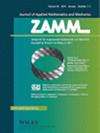Thermal evaluation of MHD boundary‐layer flow of hybridity nanofluid via a 3D sinusoidal cylinder
IF 3.2
4区 工程技术
Q1 MATHEMATICS, APPLIED
Zamm-zeitschrift Fur Angewandte Mathematik Und Mechanik
Pub Date : 2023-09-06
DOI:10.1002/zamm.202300186
引用次数: 0
Abstract
The study of the boundary layer is considered one of the most important theories in the field of heat and mass transfer because of its important explanation that shows us the behavior of different surfaces while they are under the influence of the flow accompanied by different thermal forces. The study of corrugated surfaces is one of the engineering applications, such as flow in heat exchangers or solar cells or cooling processes during surface heat treatments. This model is also used in medical applications such as flow in arteries or movement in the intestines. So, the work deals with investigating the boundary layer surrounding a three‐dimensional sinusoidal pipe; the boundary layer was assumed to be filled with a hybrid nanofluid consisting of water +Cu nanoparticles as the main fluid, supported by a small concentration of Al2O3 or Ag nanoparticles. The boundary layer is described by a set of nonlinear partial differential equations due to the continuity, momentum, and energy equations, which are transformed into a set of dependently coupled nonlinear ordinary differential equations. The obtained system of equations was solved using numerical techniques. The behavior of the boundary layer under the varying types and concentrations of nanoparticles and the influence of the magnetic field has been depicted by a set of graphs and tables. With reference to some results, it is found that using 5% of nanoparticles of aluminum oxide raises the rate of cooling by 8% and using 5% of silver nanoparticles increases it by 5%.混合纳米流体MHD边界层流动的三维正弦圆柱体热评价
边界层的研究被认为是传热传质领域中最重要的理论之一,因为它重要地解释了不同表面在不同热作用力的流动作用下的行为。波纹表面的研究是工程应用之一,如热交换器或太阳能电池的流动或表面热处理过程中的冷却过程。该模型也用于医疗应用,如动脉流动或肠道运动。因此,这项工作是研究三维正弦管道周围的边界层;假设边界层被以水+Cu纳米颗粒为主的混合纳米流体填充,由小浓度的Al2O3或Ag纳米颗粒支撑。边界层由一组非线性偏微分方程描述,由于连续性、动量和能量方程,这些方程转化为一组依赖耦合的非线性常微分方程。用数值方法求解得到的方程组。用一组图形和表格描述了在不同类型和浓度的纳米粒子作用下边界层的行为以及磁场的影响。参考一些实验结果,发现使用5%的氧化铝纳米粒子可使冷却速率提高8%,使用5%的银纳米粒子可使冷却速率提高5%。
本文章由计算机程序翻译,如有差异,请以英文原文为准。
求助全文
约1分钟内获得全文
求助全文
来源期刊
CiteScore
3.30
自引率
8.70%
发文量
199
审稿时长
3.0 months
期刊介绍:
ZAMM is one of the oldest journals in the field of applied mathematics and mechanics and is read by scientists all over the world. The aim and scope of ZAMM is the publication of new results and review articles and information on applied mathematics (mainly numerical mathematics and various applications of analysis, in particular numerical aspects of differential and integral equations), on the entire field of theoretical and applied mechanics (solid mechanics, fluid mechanics, thermodynamics). ZAMM is also open to essential contributions on mathematics in industrial applications.

 求助内容:
求助内容: 应助结果提醒方式:
应助结果提醒方式:


